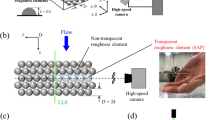Abstract
Using data from more than 40 rivers in the middle Yellow River basin, a study has been made of the influence of coupled wind-water processes on hyperconcentrated flows. A simple “vehicle” model has been proposed to describe hyperconcentrated flows. The liquid phase of two-phase flows is a “vehicle”, in which coarse sediment particles are carried as solid-phase The formation and characteristics of hyperconcentrated flows are closely related with the formation and characteristics of this liquid-phase and solid-phase. Surface materials and geomorphic agents of the middle Yellow River basin form some patterns of combination, which have deep influence on the formation and characteristics of liquid- and solid-phases of hyperconcentrated flows. The combination of high percentages of relatively coarse material with low percentages of fine material appears in the area predominated by the wind process, where the supply of relatively coarse sediment is sufficient, but the supply of relatively coarse sediment is not. The combination of low percentages of relatively coarse material with high percentages of fine material appears in the area predominated by the water process, where the supply of fine sediment is sufficient, but the supply of fine sediment is not. In the area predominated by coupled wind-water processes appears the combination of medium percentages of coarse and fine materials, and thus both coarse and fine sediments are in relatively sufficient supply. The manner in which the mean annual sediment concentrations of liquid- and solid-phases vary with total suspended sediment concentration is different. With the increased total suspended sediment concentration, mean annual sediment concentration of liquid-phase increased to a limit and then remained constant; however, mean annual sediment concentrations of solid-phase increased continuously. Thus, the magnitude of total suspended sediment concentration depends on the supply conditions of relatively coarse sediment and the ability of the flow to carry these relatively coarse sediment particles. In the area predominated by wind process, both the liquid- and the solid-phases cannot develop well, and their concentrations are low. In the area predominated by the water process, the mean annual sediment concentrations of liquid- and solid-phases are also low. Only in the area predominated by coupled wind-water processes, can the conditions most favor the development of both the liquid- and solid-phases, and then the peaks of mean annual sediment concentrations of liquid- and solid-phases appear. Low values of suspended sediment concentrations appear in the areas predominated by the wind process or by the water process, a fact indicating that the predominating wind process or water process does not favor the development of hyperconcentrated flows. Peak values.appear in the area where the coupled wind-water processes are predominated, indicating that the coupled wind-water processes most favor the development of hyperconcentrated flows.
Similar content being viewed by others
References
Chien, N., A Study of Hyperconcentrated flows (in Chinese), Beijing: Tsinghua University Press, 1989, 1–204.
Xu, J.X., A study of physicogeographical factors for formation of hyperconcentrated flows in the Loess Plateau of China, Geomorphology, 1998, 24: 245–255.
Chien, N., Wan, Z. H., Qian, Y.Y., The flow with heavy sediment concentration in the Yellow River basin, Journal of Tsinghua University, 1979, 19(2): 1–17.
Chien, N. and Wan Z. H., Mechanics of Sediment Movement (in Chinese), Beijing: Science Press, 1983, 1–656.
Chien, N. and Wan, Z. H., A Critical Review of the Research on the Hyperconcentrated flow in China, Series Publication of International Research and Training Center for Erosion and Sedimentation (IRTCES), Beijing, 1986.
Zhao, W. L., Sedimentation of the Yellow River (in Chinese), Zhengzhou: Yellow River Water Conservancy Press, 1996.
Xu, J. X, Erosion caused by hyperconcentrated flow on the Loess Plateau of China, Catena, 1999, 36: 1–19.
Hodgson, K.A., Manville, V.R., Sedimentology and flow behavior of a raintriggered lahar, Stream, Ruapehu volcano, New Zealand, Bulletin of the Geological Society of America, 1999, 111(5): 743–754.
Wijdenes, D. J. O., Ergenzinger, P., Erosion and sediment transport on steep marly hillslopes, Draix, Haute-Provence, France: An experimental field study, Catena, 1998, 33(3-4): 179–200.
Batalla, R. J., De Jong, C., Ergenzinger, P., Sala, M., Field observations on hyperconcentrated flows in mountain torrents, Earth Surface Processes and Landforms, 1998, 24(3): 247–253.
Cannon, S. H., Powers, P. S., Savage, W. Z., Firerelated hyperconcentrated and debris flows on Storm King Mountain, Glenwood Springs, Colorado, USA, Environmental Geology, 1998, 35(2–3): 210–218.
Wang. X. K., Chien, N., Hu, W. D., The formation and process of confluence of the flow at hyperconcentration in the gullied hilly loess areas of the Yellow River Basin, Journal of Hydraulic Engineering (in Chinese), 1982, (7): 26–35.
Xu, J.X., The windwater twophase erosion and sediment producing processes in the middle Yellow River basin, Science in China,Series D, 2000, 43(2): 176–186.
Liu, D.S., Loess in the Middle Yellow River Basin (in Chinese), Beijing: Science Press, 1964.
Chien, N., Wang, K. X., Yan, L. D. et al., The source of coarse sediment in the middle reaches of the Yellow River and its effect on the siltation of the lower Yellow River, in: Proceedings of the 1st International Symposium on River Sedimentation held in Beijing, Chinese Society of Hydraulic Engineering Beijing: Guanhua Press, 1980, 53–62.
Tang, K. L., Soil Erosion on the Loess Plateau and Its Control (in Chinese), Beijing: China Science and Technology Press, 1991.
Jing, K., Chen, Y. Z., Li, F. X., Sediment and Environment of Yellow River Basin (in Chinese), Beijing: Science Press, 1993.
Chien, N., Zhang, R., Zhou, Z. D., A Study of Channel Processes (in Chinese), Beijing: Science Press, 1987.
Author information
Authors and Affiliations
Corresponding author
Rights and permissions
About this article
Cite this article
Xu, J. Hyperconcentrated flows as influenced by coupled wind-water processes. Sci. China Ser. D-Earth Sci. 48, 1990–2000 (2005). https://doi.org/10.1360/04yd0307
Received:
Revised:
Issue Date:
DOI: https://doi.org/10.1360/04yd0307




